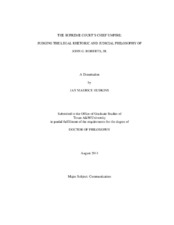| dc.description.abstract | Many Supreme Court followers contended that Judge John Roberts entered his Supreme Court confirmation hearings as a "stealth candidate" who lacked a paper trail the Judiciary Committee could vet to discern the interpretive approach, or judicial philosophy, to which Judge Roberts' subscribed. This dissertation used rhetorical criticism as a methodological approach for examining this claim. A close-reading of Roberts' law journal articles, his writings from his service during the Reagan and Bush (41) administrations, the text of his appellate court confirmation testimony and published opinions, and the text of his Supreme Court confirmation testimony and published opinions reveals that Roberts was not a "stealth candidate" but instead a jurist who resolved constitutional, judicial, political, and statutory issues by incorporating components of originalism and positivism into his prudentialist judicial philosophy.
The first two chapters of the dissertation provide the requisite background for the study. Chapter I discusses the challenges of the nomination and confirmation processes for Supreme Court Justices, and the chapter discusses the crucial powers that the Chief Justice possesses. Chapter II introduces readers to legal arguments, argument modalities, and judicial philosophies, and the chapter offers a new definition for the terms "legal rhetoric" and provides a new methodology for studying judicial discourse.
The subsequent chapters comprise the core of the study. Chapter III examines Roberts' law review articles and the letters, memoranda, and position papers he wrote while working for the Reagan and Bush administrations, Chapter IV investigates Roberts' appellate court confirmation testimony and his published opinions, and Chapter V investigates Roberts' Supreme Court confirmation testimony and his published opinions. Following a chronological approach reveals that Roberts consistently used certain argument types within corresponding argument modalities to formulate his argumentative strategies, and each chapter demonstrates that Roberts' adhered to a prudentialist interpretive approach to resolve constitutional and statutory questions. Finally, Chapter VI argues that scholars should examine judicial discourse from an interdisciplinary perspective and reevaluate their conceptions about legal rhetoric and rhetorical criticism. | en |


